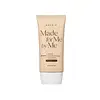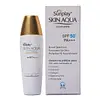What's inside
What's inside
 Key Ingredients
Key Ingredients

 Benefits
Benefits

 Concerns
Concerns

 Ingredients Side-by-side
Ingredients Side-by-side

Water
Skin ConditioningGlycerin
HumectantEthylhexyl Salicylate
UV AbsorberHomosalate
Skin ConditioningButyloctyl Salicylate
Skin ConditioningDibutyl Adipate
EmollientBis-Ethylhexyloxyphenol Methoxyphenyl Triazine
Skin ConditioningNiacinamide
SmoothingMethylene Bis-Benzotriazolyl Tetramethylbutylphenol
UV FilterPolysilicone-15
UV FilterCaprylyl Methicone
Skin ConditioningDiethylamino Hydroxybenzoyl Hexyl Benzoate
UV FilterPolymethylsilsesquioxane
Propanediol
SolventAdenosine
Skin ConditioningVaccinium Macrocarpon Fruit Extract
AstringentLactobacillus Ferment
Skin ConditioningSaccharomyces Ferment Filtrate
HumectantGalactomyces Ferment Filtrate
HumectantSaccharomyces/Xylinum/Black Tea Ferment
Skin ConditioningCaprylyl Glycol
EmollientTocopherol
AntioxidantBifida Ferment Lysate
Skin ConditioningPentylene Glycol
Skin Conditioning1,2-Hexanediol
Skin ConditioningVp/Eicosene Copolymer
Polyglyceryl-3 Methylglucose Distearate
EmulsifyingSilica
AbrasiveBehenyl Alcohol
EmollientTromethamine
BufferingDecyl Glucoside
CleansingCarbomer
Emulsion StabilisingAcrylates/C10-30 Alkyl Acrylate Crosspolymer
Emulsion StabilisingSodium Stearoyl Glutamate
CleansingPolyacrylate Crosspolymer-6
Emulsion StabilisingEthylhexylglycerin
Skin ConditioningJuniperus Virginiana Oil
MaskingSodium Polyacrylate
AbsorbentCedrus Atlantica Bark Oil
MaskingAmyris Balsamifera Bark Oil
MaskingPropylene Glycol
HumectantCopaifera Officinalis Resin
MaskingPogostemon Cablin Leaf Oil
MaskingXanthan Gum
EmulsifyingPolyether-1
Water, Glycerin, Ethylhexyl Salicylate, Homosalate, Butyloctyl Salicylate, Dibutyl Adipate, Bis-Ethylhexyloxyphenol Methoxyphenyl Triazine, Niacinamide, Methylene Bis-Benzotriazolyl Tetramethylbutylphenol, Polysilicone-15, Caprylyl Methicone, Diethylamino Hydroxybenzoyl Hexyl Benzoate, Polymethylsilsesquioxane, Propanediol, Adenosine, Vaccinium Macrocarpon Fruit Extract, Lactobacillus Ferment, Saccharomyces Ferment Filtrate, Galactomyces Ferment Filtrate, Saccharomyces/Xylinum/Black Tea Ferment, Caprylyl Glycol, Tocopherol, Bifida Ferment Lysate, Pentylene Glycol, 1,2-Hexanediol, Vp/Eicosene Copolymer, Polyglyceryl-3 Methylglucose Distearate, Silica, Behenyl Alcohol, Tromethamine, Decyl Glucoside, Carbomer, Acrylates/C10-30 Alkyl Acrylate Crosspolymer, Sodium Stearoyl Glutamate, Polyacrylate Crosspolymer-6, Ethylhexylglycerin, Juniperus Virginiana Oil, Sodium Polyacrylate, Cedrus Atlantica Bark Oil, Amyris Balsamifera Bark Oil, Propylene Glycol, Copaifera Officinalis Resin, Pogostemon Cablin Leaf Oil, Xanthan Gum, Polyether-1
Water
Skin ConditioningCyclopentasiloxane
EmollientEthylhexyl Methoxycinnamate
UV AbsorberZinc Oxide
Cosmetic ColorantButylene Glycol
HumectantGlycerin
HumectantIsononyl Isononanoate
EmollientPEG-9 Polydimethylsiloxyethyl Dimethicone
EmulsifyingAscorbyl Glucoside
AntioxidantSilica
AbrasivePolymethylsilsesquioxane
Disodium Phosphate
BufferingEthylhexyl Dimethoxybenzylidene Dioxoimidazolidine Propionate
UV AbsorberLauroyl Lysine
Skin ConditioningTitanium Dioxide
Cosmetic ColorantAcrylates/Dimethicone Copolymer
Skin ConditioningMethyl/Phenyl Polysilsesquioxane
Sodium Hydroxide
BufferingMethylparaben
PreservativeDisodium EDTA
Propylparaben
PreservativeStearyl Glycyrrhetinate
Skin ConditioningPotassium Hydroxide
BufferingArginine
MaskingHyaluronic Acid
HumectantTocopheryl Acetate
AntioxidantHydrolyzed Collagen
EmollientWater, Cyclopentasiloxane, Ethylhexyl Methoxycinnamate, Zinc Oxide, Butylene Glycol, Glycerin, Isononyl Isononanoate, PEG-9 Polydimethylsiloxyethyl Dimethicone, Ascorbyl Glucoside, Silica, Polymethylsilsesquioxane, Disodium Phosphate, Ethylhexyl Dimethoxybenzylidene Dioxoimidazolidine Propionate, Lauroyl Lysine, Titanium Dioxide, Acrylates/Dimethicone Copolymer, Methyl/Phenyl Polysilsesquioxane, Sodium Hydroxide, Methylparaben, Disodium EDTA, Propylparaben, Stearyl Glycyrrhetinate, Potassium Hydroxide, Arginine, Hyaluronic Acid, Tocopheryl Acetate, Hydrolyzed Collagen
Ingredients Explained
These ingredients are found in both products.
Ingredients higher up in an ingredient list are typically present in a larger amount.
Glycerin is already naturally found in your skin. It helps moisturize and protect your skin.
A study from 2016 found glycerin to be more effective as a humectant than AHAs and hyaluronic acid.
As a humectant, it helps the skin stay hydrated by pulling moisture to your skin. The low molecular weight of glycerin allows it to pull moisture into the deeper layers of your skin.
Hydrated skin improves your skin barrier; Your skin barrier helps protect against irritants and bacteria.
Glycerin has also been found to have antimicrobial and antiviral properties. Due to these properties, glycerin is often used in wound and burn treatments.
In cosmetics, glycerin is usually derived from plants such as soybean or palm. However, it can also be sourced from animals, such as tallow or animal fat.
This ingredient is organic, colorless, odorless, and non-toxic.
Glycerin is the name for this ingredient in American English. British English uses Glycerol/Glycerine.
Learn more about GlycerinPolymethylsilsesquioxane is a silicone used as a film forming agent.
When applied to the skin, this ingredient creates an invisible film on the surface. This film still allows oxygen to pass through, but prevents moisture from escaping. This can help condition and hydrate the skin. It also leaves a silky feel when applied.
Polymethylsilsesquioxane has not been shown to clog pores. It has been deemed safe to use up to 55%, but most cosmetics use much less.
If you have concerns about using this ingredient, we recommend speaking with a professional.
Learn more about PolymethylsilsesquioxaneSilica, also known as silicon dioxide, is a naturally occurring mineral. It is used as a fine, spherical, and porous powder in cosmetics.
Though it has exfoliant properties, the function of silica varies depending on the product.
The unique structure of silica enhances the spreadability and adds smoothness, making it a great texture enhancer.
It is also used as an active carrier, emulsifier, and mattifier due to its ability to absorb excess oil.
In some products, tiny microneedles called spicules are made from silica or hydrolyzed sponge. When you rub them in, they lightly polish away dead skin layers and enhance the penetration of active ingredients.
Learn more about SilicaWater. It's the most common cosmetic ingredient of all. You'll usually see it at the top of ingredient lists, meaning that it makes up the largest part of the product.
So why is it so popular? Water most often acts as a solvent - this means that it helps dissolve other ingredients into the formulation.
You'll also recognize water as that liquid we all need to stay alive. If you see this, drink a glass of water. Stay hydrated!
Learn more about Water